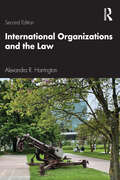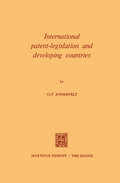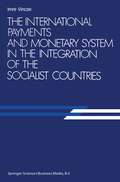- Table View
- List View
International Organizations and the Fight for Accountability: The Remedies and Reparations Gap
by Carla FerstmanInternational organizations have increasingly taken on state or quasi state-like functions in order to exercise control over individuals and societies, most pressingly in contexts of conflict and transition. Their engagement in peace operations has progressively widened, with mandates now regularly including the protection of civilian populations and, in several new operations, containing peace enforcement responsibilities with active combat duties. This increases the risk that their conduct may infringe human rights and international humanitarian law. This book explores the ways in which the principles of accountability and reparation apply to international organizations. When considering whether international organizations are obliged to afford reparation and to whom it is owed, as well as what it entails, we are confronted with the challenge of understanding how the law of responsibility intersects with specialized regimes of human rights and international humanitarian law, particularly in its application to individuals. The justifications for organizational immunities and other limits on international organizations' responsibilities were conceived to ensure IOs independence from state influences and their capacity to engage in often difficult circumstances. Many, if not all, of these rationales remain relevant today, yet disciplinary, oversight, and judicial structures that exist in state administrations to promote accountability and forestall abuses have only partially been put into place for international organizations. At the same time, individuals affected by their conduct have had no, or only cursory recourse to domestic, regional and international courts and they have not been able to rely on their states of nationality to pursue claims on their behalf.
International Organizations and the Fight for Accountability: The Remedies and Reparations Gap
by Carla FerstmanInternational organizations have increasingly taken on state or quasi state-like functions in order to exercise control over individuals and societies, most pressingly in contexts of conflict and transition. Their engagement in peace operations has progressively widened, with mandates now regularly including the protection of civilian populations and, in several new operations, containing peace enforcement responsibilities with active combat duties. This increases the risk that their conduct may infringe human rights and international humanitarian law. This book explores the ways in which the principles of accountability and reparation apply to international organizations. When considering whether international organizations are obliged to afford reparation and to whom it is owed, as well as what it entails, we are confronted with the challenge of understanding how the law of responsibility intersects with specialized regimes of human rights and international humanitarian law, particularly in its application to individuals. The justifications for organizational immunities and other limits on international organizations' responsibilities were conceived to ensure IOs independence from state influences and their capacity to engage in often difficult circumstances. Many, if not all, of these rationales remain relevant today, yet disciplinary, oversight, and judicial structures that exist in state administrations to promote accountability and forestall abuses have only partially been put into place for international organizations. At the same time, individuals affected by their conduct have had no, or only cursory recourse to domestic, regional and international courts and they have not been able to rely on their states of nationality to pursue claims on their behalf.
International Organizations and the Law
by Alexandra HarringtonDelving into the law and meaning of international organizations, this book addresses the laws relating to international organizations, their undertakings, and the ways in which specific international organizations function and interact with one another. Assuming little background knowledge of international law, the book brings together key issues in international law and the history of international organizations in a cohesive manner, providing readers with a clear understanding of international organizations' law in context. It addresses topics such as: organization functions and structure membership and membership powers the rights of international organizations dispute settlement in international organizations termination of an international organization Written in an accessible and engaging way, this book is ideal reading for students new to the Law of International Organizations and as a reference for those active in fields impacted by international organizations.
International Organizations and the Law
by Alexandra HarringtonDelving into the law and meaning of international organizations, this book addresses the laws relating to international organizations, their undertakings, and the ways in which specific international organizations function and interact with one another. Assuming little background knowledge of international law, the book brings together key issues in international law and the history of international organizations in a cohesive manner, providing readers with a clear understanding of international organizations' law in context. It addresses topics such as: organization functions and structure membership and membership powers the rights of international organizations dispute settlement in international organizations termination of an international organization Written in an accessible and engaging way, this book is ideal reading for students new to the Law of International Organizations and as a reference for those active in fields impacted by international organizations.
International Organizations and the Law
by Alexandra R. HarringtonInternational Organizations and the Law addresses the laws relating to international organizations, their undertakings and the ways in which specific international organizations function and interact with one another. Assuming little background knowledge of international law, the book brings together key issues in international law and the history of international organizations in a cohesive manner, providing readers with a clear understanding of international organizations’ law in context. It addresses topics such as: organization functions and structure membership and membership powers the rights of international organizations dispute settlement in international organizations termination of an international organization. The second edition has been fully revised and updated to include coverage of the COVID-19 pandemic and its impact on the functions of international organizations; the invasion of Ukraine and the stresses placed on the UN, NATO and the international community; increased efforts in the climate change sector; and the overhaul of the NAFTA system and the impact of Brexit. Written in an accessible and engaging way, this book is ideal reading for students new to the law of international organizations and as a reference for those active in fields impacted by international organizations.
International Organizations and the Law
by Alexandra R. HarringtonInternational Organizations and the Law addresses the laws relating to international organizations, their undertakings and the ways in which specific international organizations function and interact with one another. Assuming little background knowledge of international law, the book brings together key issues in international law and the history of international organizations in a cohesive manner, providing readers with a clear understanding of international organizations’ law in context. It addresses topics such as: organization functions and structure membership and membership powers the rights of international organizations dispute settlement in international organizations termination of an international organization. The second edition has been fully revised and updated to include coverage of the COVID-19 pandemic and its impact on the functions of international organizations; the invasion of Ukraine and the stresses placed on the UN, NATO and the international community; increased efforts in the climate change sector; and the overhaul of the NAFTA system and the impact of Brexit. Written in an accessible and engaging way, this book is ideal reading for students new to the law of international organizations and as a reference for those active in fields impacted by international organizations.
International Parental Child Abduction and the Law: The Case of Japan
by Geraldine CarneyJapan has faced widespread scrutiny for failing to properly address international parental child abduction involving its citizens. This book examines how and why Japan has come to have this tarnished image, its response, and how it might manage these disputes in the future. In particular, the book explores how Japan engages with international legal frameworks to manage international parental child abduction and what this means, in reality, for Japanese people and others who come under its wide umbrella. A focus of this examination is how the key international treaty, the Hague Convention of 25 October 1980 on the Civil Aspects of International Child Abduction, has fared since being introduced in Japan in 2014. Case studies of parental child abduction involving Japan are used throughout to illustrate the legal and social concepts discussed in the book. The struggles of both abducting and left-behind parents across fluid international borders reveal seismic social and philosophical shifts in Japan that continue to shape its legal landscape. This book will be a useful resource for students of Japanese Studies, Sociolegal Studies, Comparative Law and International Law.
International Parental Child Abduction and the Law: The Case of Japan
by Geraldine CarneyJapan has faced widespread scrutiny for failing to properly address international parental child abduction involving its citizens. This book examines how and why Japan has come to have this tarnished image, its response, and how it might manage these disputes in the future. In particular, the book explores how Japan engages with international legal frameworks to manage international parental child abduction and what this means, in reality, for Japanese people and others who come under its wide umbrella. A focus of this examination is how the key international treaty, the Hague Convention of 25 October 1980 on the Civil Aspects of International Child Abduction, has fared since being introduced in Japan in 2014. Case studies of parental child abduction involving Japan are used throughout to illustrate the legal and social concepts discussed in the book. The struggles of both abducting and left-behind parents across fluid international borders reveal seismic social and philosophical shifts in Japan that continue to shape its legal landscape. This book will be a useful resource for students of Japanese Studies, Sociolegal Studies, Comparative Law and International Law.
International Patent-Legislation and Developing Countries
by Ulf AnderfeltTHE INTERNATIONAL PATENT-LEGISLATION AND DEVELOPING COUNTRIES A major concern today in many fields of international cooperation is the development of the nonindustrialized part of the world. This was not always so. Until fairly recently contacts among States were basi cally limited to diplomatic intercourse. The concept of State sovereign ty naturally led to the application of the principle of legal reciprocity between States. In the few areas outside diplomatic relations where international cooperation developed during the last century the same principle of legal reciprocity was applied. The cooperation that did take place was mostly among a limited number of Western States. In case countries outside this group wished to participate they were free to do so on accepting the traditional standards for such cooperation. Though a few countries, which today would have been or are known as develop ing countries, did join in various schemes of international cooperation, the majority of them remained outside. Moreover, a large number of States, which today are known as developing, did not exist as sovereign States at the time. One of the areas in which a system of international cooperation was set up in the latter part of the nineteenth century was that of patent protection.
International Patent Rights Harmonisation: The Case of China
by Weinian HuWith reference to China, this book examines the course of international patent rights harmonisation; its characteristics as well as impediments. It evaluates the case of China’s patent law development over the course of the last three decades by drawing on the most up-to-date Chinese language sources. In the process, the volume focuses on China’s patent legislation, its achievements and weaknesses, as well as the intrinsic limitations, especially as far as enforcement is concerned. The author pays close attention to the unique societal background in China, a country that did not provide constitutional recognition to private property rights until 2004 and where a property law entered into force as late as 2013, 30 years after the first promulgation of the patent law. Global trade policy makers, IP professionals and businesses will benefit from the insights presented by the chapters as they will help them to appreciate the achievements and the controversies pursuant to China’s efforts in patent protection. While serving as a useful case study for countries seeking to leverage patent protection as a driver for economic development, the book will equally facilitate Chinese legislature to reflect on its patent legislation development, specifically on legislative policy choices. An additional analytical strength of the volume is that it compares the Chinese patent legislation with the American Invents Act and the European Patent Convention. It discovers the differences between the three patent legislations by using the minimum patent protection standards set down by the TRIPS Agreement as the benchmark. The results of the comparisons suggest that China has successfully harmonised its patent legislation with the global patent protection system, and often opts for higher patent protection standards. The book also considers whether China could learn lessons from Japan and India in their respective patent legislation and policy choices. With China undertaking a fourth patent law amendment, the provisions contained in the second draft of the Patent Law 2015, which was published in December 2015, are included in the analysis.
International Patent Rights Harmonisation: The Case of China
by Weinian HuWith reference to China, this book examines the course of international patent rights harmonisation; its characteristics as well as impediments. It evaluates the case of China’s patent law development over the course of the last three decades by drawing on the most up-to-date Chinese language sources. In the process, the volume focuses on China’s patent legislation, its achievements and weaknesses, as well as the intrinsic limitations, especially as far as enforcement is concerned. The author pays close attention to the unique societal background in China, a country that did not provide constitutional recognition to private property rights until 2004 and where a property law entered into force as late as 2013, 30 years after the first promulgation of the patent law. Global trade policy makers, IP professionals and businesses will benefit from the insights presented by the chapters as they will help them to appreciate the achievements and the controversies pursuant to China’s efforts in patent protection. While serving as a useful case study for countries seeking to leverage patent protection as a driver for economic development, the book will equally facilitate Chinese legislature to reflect on its patent legislation development, specifically on legislative policy choices. An additional analytical strength of the volume is that it compares the Chinese patent legislation with the American Invents Act and the European Patent Convention. It discovers the differences between the three patent legislations by using the minimum patent protection standards set down by the TRIPS Agreement as the benchmark. The results of the comparisons suggest that China has successfully harmonised its patent legislation with the global patent protection system, and often opts for higher patent protection standards. The book also considers whether China could learn lessons from Japan and India in their respective patent legislation and policy choices. With China undertaking a fourth patent law amendment, the provisions contained in the second draft of the Patent Law 2015, which was published in December 2015, are included in the analysis.
The International Payments and Monetary System in the Integration of the Socialist Countries
by Imre VinczeEconomic cooperation between the CMEA countries is implemented according to the monetary and financial regulations worked out collectively. The regulations cover the organizational structure of international settlements; the choice of currency for settlements; the principles of international credit transactions ; the determination ofthe exchange rate of the currency used in international settlements to national currencies and to convertible currencies outside the CMEA; the principles and rules ofinternational exchange and transfers; mIes for the currency allotments of citizens (roles of international transfers for citizens). The regulations also contain provisions for international settlements and credit transactions which are concluded through an independent international bank or banks. These regulations, the instruments and institutions together, form the international payments and monetary system of the CMEA. * The financial and monetary regulations of the CMEA community were formed in several stages, depending on the prevailing· conditions and the targets to be attained. In the years between 1949 and 1963 the general form of economic cooperation and of international settlements was the bilateral clearing agreement. In the bilateral agreements which the Soviet Union concluded with the other CMEA countries the currency of settlements was the Soviet rouble. The prices applied in foreign trade were not the internal producer prices of the Soviet Union, but world market prices (main international market prices) expressed in roubles, with the he]p ofthe exchange rate ofthe Soviet rouble to the US dollar, as quoted in the Soviet Union.
An International Peace Court: Design for a Move from State Crime Toward World Law
by Thomas HoltonThe classical concept ofInternationalLa w, as developed by Gentilis, Gro tius and their successors, accepted as its starting point the sovereignty of states, from which it followed that (r) the rules of International Law were based upon the general consent of those states; and (2) that, since state sovereignty was not capable of limitation, otherwise than by the consent of the state itself, in the last resort, International Law must accept the fact of war. Two world wars within the space of thirty years, and the development of nuclear weapons of unlimited potential, have compelled statesmen and lawyers to take a fresh look at the foundations of international relations. The First World War was followed by the creation of the League of Nations, and by the establish ment of the Permanent Court of International Justice. The failure of both, insofar as the preservation of peace was concerned, was apparent in the continuance of international insecurity, culminating in World War II. This again was followed by the establishment of a new inter national organisation, the United Nations, with its auxiliary, the International Court of Justice. Nevertheless, international security seems further away than ever, and it may be suggested that it is the devastating potential of nuclear weapons, rather than the strength of international machinery, which has so far prevented a third general conflict far more disastrous than either of the two World Wars which have already taken place.
An International Perspective on Design Protection of Visible Spare Parts (SpringerBriefs in Law)
by Dana Beldiman Constantin Blanke-RoeserThis publication examines the legal aspects of the spare parts market from an IP perspective: specifically whether design protection for spare parts of a complex product extends to the spare part aftermarket, or whether that market should remain open to competition. The stakeholders’ equally weighty arguments that must be balanced against are, on the one hand, the property interest in an earned IP right in the design of the part; and on the other, enhanced competition, likely reflected in lower prices. The mounting tension between these two positions is manifest an increased number of lawsuits in both the US and the EU.This book provides a discussion of the legal issues involved in this debate from a global perspective, with special focus on the EU and the US. Part I contextualizes the legal debate by discussing the historical background, the competitive situation and the respective stakeholder positions. Part II examines the relevant legal questions on a comparative basis, evaluating the likelihood of its adoption in the jurisdictions examined. Concluding that adoption is unlikely, Part III proposes a number of possible considerations meant to further compromise. Part IV concludes with a future outlook, specifically in light of the impact of technological development on this market.
International Perspectives in Values-Based Mental Health Practice: Case Studies and Commentaries
by Drozdstoy Stoyanov Bill Fulford Giovanni Stanghellini Werdie Van Staden Michael Th WongThis open access book offers essential information on values-based practice (VBP): the clinical skills involved, teamwork and person-centered care, links between values and evidence, and the importance of partnerships in shared decision-making. Different cultures have different values; for example, partnership in decision-making looks very different, from the highly individualized perspective of European and North American cultures to the collective and family-oriented perspectives common in South East Asia. In turn, African cultures offer yet another perspective, one that falls between these two extremes (called batho pele).The book will benefit everyone concerned with the practical challenges of delivering mental health services. Accordingly, all contributions are developed on the basis of case vignettes, and cover a range of situations in which values underlie tensions or uncertainties regarding how to proceed in clinical practice. Examples include the patient’s autonomy and best interest, the physician’s commitment to establishing high standards of clinical governance, clinical versus community best interest, institutional versus clinical interests, patients insisting on medically unsound but legal treatments etc. Thus far, VBP publications have mainly dealt with clinical scenarios involving individual values (of clinicians and patients). Our objective with this book is to develop a model of VBP that is culturally much broader in scope. As such, it offers a vital resource for mental health stakeholders in an increasingly inter-connected world. It also offers opportunities for cross-learning in values-based practice between cultures with very different clinical care traditions.
International Perspectives on Democratization and Peace
by N. GanesanSince at least the 1990s, international mediation efforts have investigated whether civil conflicts could be resolved through democratization. The results have been mixed, and within the scholarship there is no real framework for how to approach the question, let alone any agreement on the answers. Drawing on concrete cases from three continents, and bringing together contributions from political scientists, historians, area specialists, and international relations experts, International Perspectives on Democratization and Peace takes stock of all the efforts expended in pursuit of peaceful, democratic settlements to civil conflict and provides a sorely needed framework for thinking clearly about the role of democratization in international mediation processes. In three sections, authors give a philosophical and historical elaboration of the key questions, investigate seven applied case studies that survey the impact of democratization on civil conflicts in diverse global contexts, and discuss how US preference for its own interests over international democratization has delayed, but not indefinitely forestalled, the process of democratization in many parts of the globe, a process that demands continued, serious analysis and discussion. This book is a must-read not for scholars within international relations, international political economy, development studies, political science, and peace and conflict studies.
International Perspectives on Democratization and Peace
by Narayanan GanesanSince at least the 1990s, international mediation efforts have investigated whether civil conflicts could be resolved through democratization. The results have been mixed, and within the scholarship there is no real framework for how to approach the question, let alone any agreement on the answers. Drawing on concrete cases from three continents, and bringing together contributions from political scientists, historians, area specialists, and international relations experts, International Perspectives on Democratization and Peace takes stock of all the efforts expended in pursuit of peaceful, democratic settlements to civil conflict and provides a sorely needed framework for thinking clearly about the role of democratization in international mediation processes. In three sections, authors give a philosophical and historical elaboration of the key questions, investigate seven applied case studies that survey the impact of democratization on civil conflicts in diverse global contexts, and discuss how US preference for its own interests over international democratization has delayed, but not indefinitely forestalled, the process of democratization in many parts of the globe, a process that demands continued, serious analysis and discussion. This book is a must-read not for scholars within international relations, international political economy, development studies, political science, and peace and conflict studies.
International Perspectives on Education, Religion and Law (Routledge Research in Religion and Education)
by Charles J. RussoThis volume examines the legal status of religion in education, both public and non-public, in the United States and seven other nations. It will stimulate further interest, research, and debate on comparative analyses on the role of religion in schools at a time when the place of religion is of vital interest in most parts of the world. This interdisciplinary volume includes chapters by leading academicians and is designed to serve as a resource for researchers and educational practitioners, providing readers with an enhanced awareness of strategies for addressing the role of religion in rapidly diversifying educational settings. There is currently a paucity of books devoted solely to the topic written for interdisciplinary and international audiences involving educators and lawyers, and this book will clarify the legal complexities and technical language among the law, education, and religion.
International Perspectives on Education, Religion and Law (Routledge Research in Religion and Education)
by Charles J. RussoThis volume examines the legal status of religion in education, both public and non-public, in the United States and seven other nations. It will stimulate further interest, research, and debate on comparative analyses on the role of religion in schools at a time when the place of religion is of vital interest in most parts of the world. This interdisciplinary volume includes chapters by leading academicians and is designed to serve as a resource for researchers and educational practitioners, providing readers with an enhanced awareness of strategies for addressing the role of religion in rapidly diversifying educational settings. There is currently a paucity of books devoted solely to the topic written for interdisciplinary and international audiences involving educators and lawyers, and this book will clarify the legal complexities and technical language among the law, education, and religion.
International Perspectives on Gender-Based Violence (Advances in Preventing and Treating Violence and Aggression)
by Madhumita PandeyThis book examines the multifaceted nature of gender-based violence (GBV) and the many forms it can take. It explores the area of GBV and its implications on human rights, law, and policy. The book highlights the significance of current international debates around preventing GBV and provides context for understanding GBV as a complex structural phenomenon deeply rooted in gender inequality. It addresses GBV as one of the most notable human rights violations within all societies and provides multiple global perspectives on GBV to address the common challenges and barriers to combating this issue.Key areas of coverage include:Sexual violence.Domestic violence.Intimate partner violence.Media Misogyny.Online trolling.Discrimination.Sex trafficking and modern slavery.Preventative Measures and role of men.International Perspectives on Gender-Based Violence is an essential resource for researchers, clinicians/therapists, and upper-level undergraduate and graduate students in developmental psychology, family policy, forensic psychology, human rights, public health, criminology/criminal justice, and clinical social work as well as all interrelated disciplines.
International Perspectives on Sustainability Reporting
by Dr. Amina Mohamed BuallayAs global concerns around the environment, climate, and sustainability are moving to the forefront of consumer choices and business values, how organizations report on sustainability has become more crucial than ever before. Business sustainability issues are a major concern, with many firms seeking to contribute positively when serving their local communities and enhancing their corporate responsibility practices socially and environmentally. International Perspectives on Sustainability Reporting presents business case studies from different sectors across different regions, highlighting the changing institutional contexts and laws in each country regarding sustainability reporting: for some, reporting is mandatory and for others it is voluntary. Taking not only the historical but also the firm level, sectoral, regional, political, and economic perspective, Buallay’s work is far-reaching and comprehensive, spanning from the history of environmental reporting to sustainable reporting in the tourism industry. Tackling multidisciplinary topics that include finance, economics, sociology, law, governance, and organizational management, the methods deployed here are both qualitative and quantitative. International Perspectives on Sustainability Reporting is essential reading for both scholars and practitioners in all of these sectors as sustainability increases in importance across the board.
International Perspectives on Sustainability Reporting
by Dr. Amina Mohamed BuallayAs global concerns around the environment, climate, and sustainability are moving to the forefront of consumer choices and business values, how organizations report on sustainability has become more crucial than ever before. Business sustainability issues are a major concern, with many firms seeking to contribute positively when serving their local communities and enhancing their corporate responsibility practices socially and environmentally. International Perspectives on Sustainability Reporting presents business case studies from different sectors across different regions, highlighting the changing institutional contexts and laws in each country regarding sustainability reporting: for some, reporting is mandatory and for others it is voluntary. Taking not only the historical but also the firm level, sectoral, regional, political, and economic perspective, Buallay’s work is far-reaching and comprehensive, spanning from the history of environmental reporting to sustainable reporting in the tourism industry. Tackling multidisciplinary topics that include finance, economics, sociology, law, governance, and organizational management, the methods deployed here are both qualitative and quantitative. International Perspectives on Sustainability Reporting is essential reading for both scholars and practitioners in all of these sectors as sustainability increases in importance across the board.
International Perspectives on the Regulation of Lawyers and Legal Services
by Bloomsbury PublishingThis collection explores developments in the regulation of legal services by examining the control of the markets in several key countries and in jurisdictions within countries. The contributions consider emerging adjustments in regulatory structures and methods; examine the continuing role, if any, of professionals and how this may be changing; and speculate on the future of legal services regulation in each jurisdiction. The introductory and concluding chapters draw together similarities, differences and conclusions regarding directions of change in the regulation of legal services. They consider the emergence of alternatives to professionalism as a means of regulating legal services and some implications for the rule of law.
International Perspectives on the Regulation of Lawyers and Legal Services
by Bloomsbury PublishingThis collection explores developments in the regulation of legal services by examining the control of the markets in several key countries and in jurisdictions within countries. The contributions consider emerging adjustments in regulatory structures and methods; examine the continuing role, if any, of professionals and how this may be changing; and speculate on the future of legal services regulation in each jurisdiction. The introductory and concluding chapters draw together similarities, differences and conclusions regarding directions of change in the regulation of legal services. They consider the emergence of alternatives to professionalism as a means of regulating legal services and some implications for the rule of law.

















